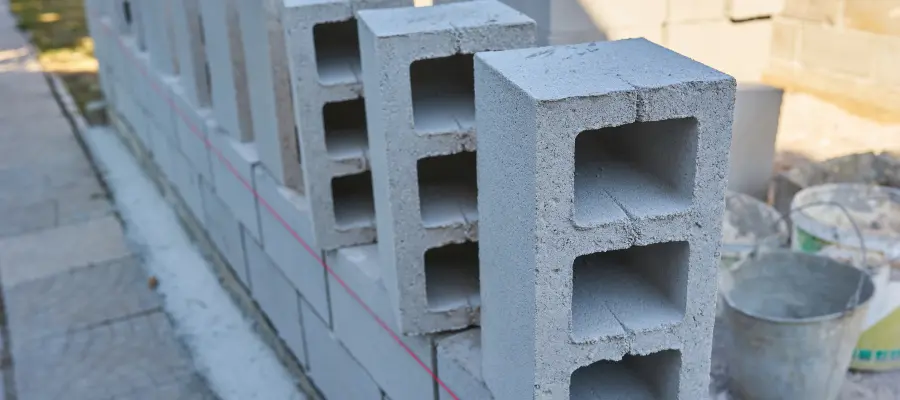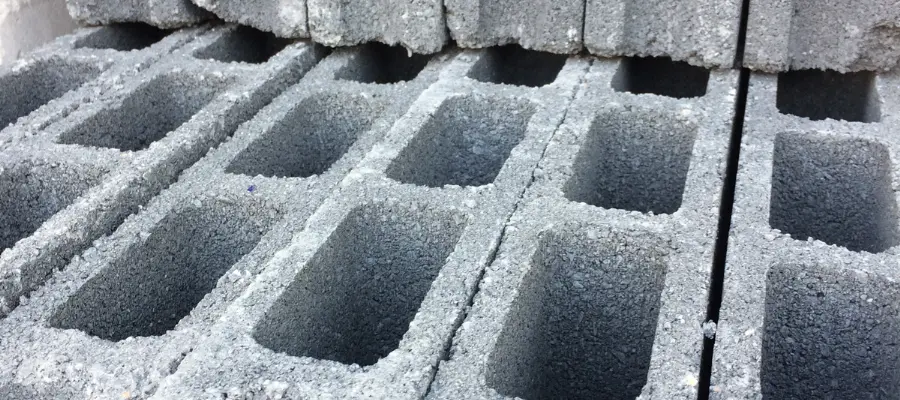In a concrete structure, the concrete blocks are a building block for the structure’s durability and stability. The concrete blocks take parts from residential homes to commercial complexes, offering a powerful foundation.
Have you ever wondered about types of concrete blocks? Of course, their types are based on projects’ specific requirements and preferences.
In today’s Brick & Bolt blog, you will learn more about the types, their features, applications, and benefits.
What are Concrete Blocks?
Concrete blocks are a type of building material made from a combination of cement, sand, and gravel. They are generally utilised in construction to form masonry, floors, and home foundations. They can also be used as foundations for other structures, like houses or commercial buildings.
Types of Concrete Blocks for Construction
There are two important types of concrete blocks: hollow and solid. Both types are generally used for wall construction and other purposes.
1. Solid Concrete Blocks
Solid blocks are denser and more robust than hollow concrete blocks, making them ideal for projects that require the utmost durability. Their solid, dense construction allows them to handle heavy weights without breaking or cracking.
Following are general types of solid concrete blocks
- Fly Ash Block
- Aerated Autoclaved Block
- Paving Block
- Cellular Lightweight Block
- Expanded Clay Aggregate Block
2. Hollow Concrete Blocks

Hollow blocks are prepared with holes or cavities, making them lighter than solid blocks. This characteristic makes them more useful when wiring or piping needs to be run through them.
Following are general types of hollow concrete blocks
- Stretcher Block
- Pillar Block
- Lintel Block
- Jamb Block
- Column Block
- Corner Block
- Splitface Block
- Bullnose Block
- Partition Block
So, let’s explore all the types of concrete blocks in detail:
Types of Solid Concrete Blocks
Fly Ash Block
Fly ash blocks are eco-friendly blocks used in Green buildings as they are made from a blend of fly ash(a waste product from coal combustion), cement, sand, and water.
Fly ash blocks are strong and provide good insulation. That’s why they are often used for partition walls, exterior walls, and load-bearing walls. These blocks are usually small because larger ones are more likely to crack.
Aerated Autoclaved Block
Aerated autoclaved blocks are lightweight construction materials made from a mix of fine aggregates, cement, lime, water, and an aerating agent. They are great for insulating and ideal for energy-efficient construction.
Since they are made of 80% air, they are weaker than denser concrete blocks and usually need reinforcement. These are available in various forms, including blocks, panels, and speciality shapes such as lintel blocks and U-shaped bond beam blocks, each offered in different thicknesses. They are also used to block out sound and are fire-resistant. They are used for walls, floors, and roofs.
Paving Block
Paving blocks are solid blocks used to create pavements. They come in square or rectangular shapes and serve various purposes, such as paving roads, walkways, driveways, and outdoor spaces. Their key advantages are durability, visual appeal, and easy installation. These blocks are available in different sizes and a wide range of colours, such as sandstone, tan, dark brown, charcoal, and light grey.
Cellular Lightweight Block
CLC blocks provide excellent sound and temperature insulation as they are composed of foam, fly ash, and cement. Used for walls and roof insulation, they are economically priced, environmentally friendly, and resistant to fire. These blocks are made to be very effective and light in weight. However, Cellular Lightweight Concrete is not the best choice for load-bearing applications
Expanded Clay Aggregate Block
Expanded clay aggregate blocks are prepared by using clay granules, cement, and water. These blocks are fire-resistant and waterproof.
They can reduce the overall structural load by as far as 50%. They also provide good sound and temperature insulation.
Types of Hollow Concrete Blocks

Hollow concrete blocks come in different sizes. Some common sizes are 4 x 8 x 16 inches, 6 x 8 x 16 inches, and 8 x 8 x 16 inches. Most hollow concrete blocks are grey in colour. But you can also find them in tan or dark red. There are several size and colour options to choose from.
Stretcher Block
Stretcher blocks are a general type of hollow block used in walls. They are characterised by their long, rectangular shape, and their faces are laid parallel to the wall’s face. Concrete stretcher blocks are used to connect the corners of masonry units.
Pillar Block
Pillar blocks, also known as double corner blocks, are versatile masonry units designed for constructing pillars, piers, and other structures where both ends of the block need to be visible. Their unique shape allows for a finished appearance on two sides, making them ideal for exposed applications. Their functionality and visual appeal make them a popular choice among masons and builders alike.
Lintel Block
Lintels, essential for supporting loads above openings like doors and windows, are crucial elements in construction projects. Lintel/channelled/beam blocks are identified by their U shape. A Lintel beam block is used for the sake of provision of a beam or lintel beam. It is usually provided on the top portion of doors and windows. After setting the blocks, this groove is filled with concrete along with reinforcement. Solid-bottom lintel blocks are available in a 6-by-8-by-16-inch configuration.
Jamb Block
Jamb blocks are special blocks with grooves used for framing doors and windows, especially double-hung windows. The grooves allow the window framing pieces to fit securely and align properly, providing structural strength when connected to other blocks like stretchers and corners.
Column Block
A column block is normally a square block with a single hole. Column blocks are developed for constructing columns and pillars, providing stability and load-bearing capacity. They can be stacked on top of one another to form columns with reinforced from the inside.
Corner Block
Corner blocks are designed to used at the ends or corners of masonry. Generally at the ends of windows and door openings. The plain side is disclosed to the exterior, while the stretcher side runs along the wall.
Splitface Block
Splitface blocks resemble pillar blocks, but with a distinct rough texture on one side, revealing the inner aggregates of the block. While they are more prone to water damage, they boast greater resilience against fires. These blocks are commonly used for decorative purposes. A typical splitface block, usually measures 6 inches in width, 8 inches in height, and 16 inches in length.
Bullnose Block
Bullnose blocks, as the name suggests, have a rounded edge and are generally used in architectural details, such as curved walls or edges.
Partition Block
Partition concrete blocks are commonly used to construct partition walls. Partition blocks have a larger height than their breadth. The hollow part is split into two to three components in case of partition blocks.
Conclusion
Concrete blocks do not just offer functionality; they also bring environmental benefits, like energy efficiency and sustainability. From fly ash blocks to aerated autoclaved blocks, innovations in block manufacturing continue to push the boundaries of what’s possible in modern construction.
Whether you’re building a residential home, a commercial complex, or a simple pavement, choosing the right type of concrete block is key to a successful project. The concrete blocks you select can ensure your project is strong, looks good, and is better for the environment.

